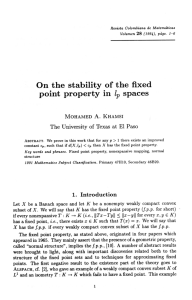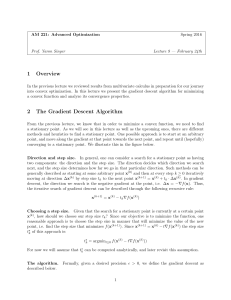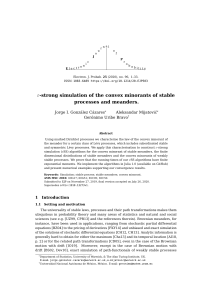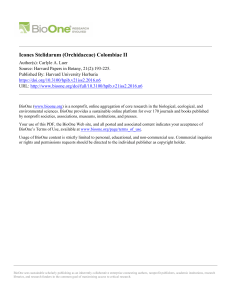Influence of peak height prior to milling the resulting surface
Anuncio
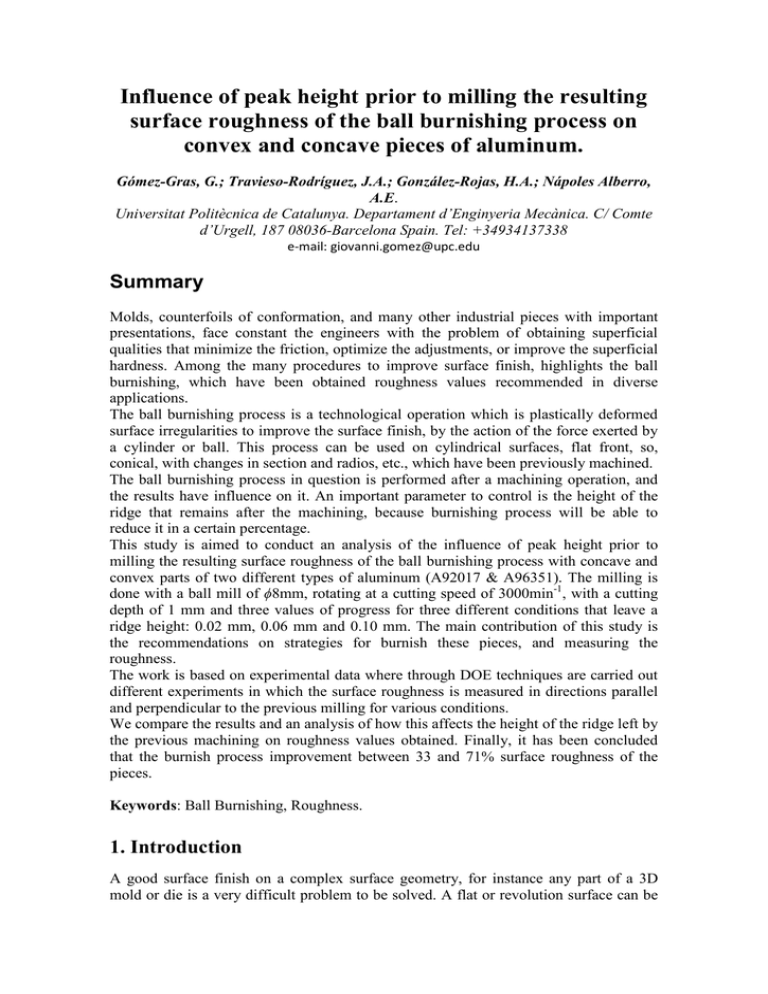
Influence of peak height prior to milling the resulting surface roughness of the ball burnishing process on convex and concave pieces of aluminum. Gómez-Gras, G.; Travieso-Rodríguez, J.A.; González-Rojas, H.A.; Nápoles Alberro, A.E. Universitat Politècnica de Catalunya. Departament d’Enginyeria Mecànica. C/ Comte d’Urgell, 187 08036-Barcelona Spain. Tel: +34934137338 e-mail: [email protected] Summary Molds, counterfoils of conformation, and many other industrial pieces with important presentations, face constant the engineers with the problem of obtaining superficial qualities that minimize the friction, optimize the adjustments, or improve the superficial hardness. Among the many procedures to improve surface finish, highlights the ball burnishing, which have been obtained roughness values recommended in diverse applications. The ball burnishing process is a technological operation which is plastically deformed surface irregularities to improve the surface finish, by the action of the force exerted by a cylinder or ball. This process can be used on cylindrical surfaces, flat front, so, conical, with changes in section and radios, etc., which have been previously machined. The ball burnishing process in question is performed after a machining operation, and the results have influence on it. An important parameter to control is the height of the ridge that remains after the machining, because burnishing process will be able to reduce it in a certain percentage. This study is aimed to conduct an analysis of the influence of peak height prior to milling the resulting surface roughness of the ball burnishing process with concave and convex parts of two different types of aluminum (A92017 & A96351). The milling is done with a ball mill of ϕ8mm, rotating at a cutting speed of 3000min-1, with a cutting depth of 1 mm and three values of progress for three different conditions that leave a ridge height: 0.02 mm, 0.06 mm and 0.10 mm. The main contribution of this study is the recommendations on strategies for burnish these pieces, and measuring the roughness. The work is based on experimental data where through DOE techniques are carried out different experiments in which the surface roughness is measured in directions parallel and perpendicular to the previous milling for various conditions. We compare the results and an analysis of how this affects the height of the ridge left by the previous machining on roughness values obtained. Finally, it has been concluded that the burnish process improvement between 33 and 71% surface roughness of the pieces. Keywords: Ball Burnishing, Roughness. 1. Introduction A good surface finish on a complex surface geometry, for instance any part of a 3D mold or die is a very difficult problem to be solved. A flat or revolution surface can be produced relatively easily in a grinding machine, thereby improving its finish is relatively simple. When the development surface is complex, improving its quality is not that simple and that is when this process is a problem. In this case we have developed a study to improve the surface finish of concave and convex configurations through a ball burnishing process developed in the same milling machine in which the workpiece in question has been developed. Through a ball burnishing operation [1] complex configuration surfaces could be machined to obtain a good surface finish on them. As shown in figure 1, this process is developed using a tool that is mounted on a hydraulic head, which will apply some pressure to a ball. When this ball glides on the workpiece area, it deforms the peaks of the surface irregularities, flattening the surface profile and producing a much more regular surface than the one that the workpiece had before. Figure 1. Schematic representation of the Ball Burnishing process Sobre los resultados de rugosidad superficial obtenidos en las piezas procesadas a través de un proceso de bruñido con bola influyen diferentes variables. Algunas de estas variables son los parámetros de funcionamiento del propio proceso (velocidad de avance, paso lateral de la herramienta, presión), pero también hay una influencia directa del proceso de mecanizado anterior al bruñido y específicamente la rugosidad superficial que queda producto de éste. Esta rugosidad puede ser valorada a través de la altura de cresta que deja el proceso de fresado previo al bruñido. En este trabajo se diseñó un experimento con el objetivo de demostrar la influencia de esta altura de cresta, sobre los resultados de rugosidad superficial que se pueden obtener tras la aplicación del bruñido. A ball burnishing process is recommended because the tool can be easily installed on the same CNC machine. The ball can have diameters between 3 and 12 mm and it operates under the action of a normal force high enough to deform the peaks of the surface profile to be treated. The ball is in contact with the surface just for burnishing it, but it can freely rotate on itself, because the values of friction forces are very small. As it happens in the cutting process, plastic deformation is produced on the entire surface because the tool is constantly impacting on the workpiece [2, 3, 4, 5, 6]. 2. Experiments The experiments were performed on workpieces with convex and concave surfaces of two different materials: the aluminium A92017 and A96351. The workpieces have the shape of figure 2. Convex or concave surfaces of the workpieces are composed of three zones in which there are three curves of 50, 90 and 50 mm of diameter respectively. These curves have been machined by using a spherical mill with 8 mm of diameter. La pieza a su vez se divide en tres áreas, las cuales están diferenciadas básicamente por la altura de cresta que deja el fresado previo. En el área 1, la altura de cresta es de 0,02 mm, en el área 2 es de 0,06mm y en el área 3 de 0,10mm (figura 2). De estudios anteriores [x] se conoce que las condiciones óptimas para mecanizar este tipo de piezas son: • • • • Velocidad de avance de la herramienta de bruñido (Va)= 500mm/min Estrategia de mecanizado (E)= perpendicular al fresado Paso lateral de la herramienta (b)= 0,08mm Presión de trabajo de la herramienta (P)= 1,5bar Tomando estos parámetros de funcionamiento constantes, se deja solamente como variable la altura de cresta del fresado previo y se analiza su influencia en los resultados del proceso. Figure 2. Workpieces used for testing surface roughness after burnishing Se realizan 6 experimentos, 2 en cada área de cada pieza. El objetivo de la duplicidad de los experimentos, es demostrar que estadísticamente existe una correlación entre la variable altura de cresta y los resultados obtenidos de rugosidad en cada caso. Regarding the results of the measurements four indicators of surface roughness have been taken into account: Ra (average surface roughness) and Rt (peak-valley maximal surface roughness), and both in the parallel direction of tool feed-rate (Ra // and Rt //) and in the perpendicular direction to the tool feed-rate (Ra ⊥ and Rt ⊥). Se utilizó la prueba de F de fisher para buscar la correlación entre los resultados (para cada uno de los indicadores mencionados anteriormente) y la variable altura de cresta. Para el caso de la Ra// en la probeta de aluminio A92017 y en la zona de radio 50mm, los resultados obtenidos son los que se muestran en el gráfico de la figura 3. F1= F2= F1>F2 Una vez demostrada que existe correlación entre los resultados alcanzados, para cada uno de los indicadores, se puede pasar a analizar los resultados. Estos resultados se encuentran resumidos en la Tabla 1. Material A92017 A92017 A92017 A92017 A92017 A92017 A92017 A92017 A92017 A92017 A92017 A92017 A96351 A96351 A96351 A96351 A96351 A96351 A96351 A96351 A96351 Workpiece tipus Concave Concave Concave Concave Concave Concave Convex Convex Convex Convex Convex Convex Concave Concave Concave Concave Concave Concave Convex Convex Convex r (mm) 50 50 50 50 50 50 50 50 50 50 50 50 50 50 50 50 50 50 50 50 50 hc (mm) 0.02 0.02 0.06 0.06 0.10 0.10 0.02 0.02 0.06 0.06 0.10 0.10 0.02 0.02 0.06 0.06 0.10 0.10 0.02 0.02 0.06 Ra // (μm) 1.974 1.904 2.058 2.150 2.206 2.220 0.898 0.786 1.068 1.006 1.100 1.158 0.775 0.806 0.855 0.852 0.913 0.905 0.510 0.562 0.710 Rt // (μm) 15.085 14.933 15.266 15.250 15.670 15.700 4.992 4.898 5.122 5.130 5.708 5.996 4.524 4.995 7.450 7.930 8.430 8.640 6.052 6.452 6.988 Ra ⊥ (μm) Rt ⊥ (μm) A96351 A96351 A96351 A92017 A92017 A92017 A92017 A92017 A92017 A92017 A92017 A92017 A92017 A92017 A92017 A96351 A96351 A96351 A96351 A96351 A96351 A96351 A96351 A96351 A96351 A96351 A96351 Convex Convex Convex Concave Concave Concave Concave Concave Concave Convex Convex Convex Convex Convex Convex Concave Concave Concave Concave Concave Concave Convex Convex Convex Convex Convex Convex 50 50 50 90 90 90 90 90 90 90 90 90 90 90 90 90 90 90 90 90 90 90 90 90 90 90 90 0.06 0.10 0.10 0.02 0.02 0.06 0.06 0.10 0.10 0.02 0.02 0.06 0.06 0.10 0.10 0.02 0.02 0.06 0.06 0.10 0.10 0.02 0.02 0.06 0.06 0.10 0.10 0.745 0.752 0.776 0.662 0.502 0.740 0.725 0.826 0.800 0.516 0.448 0.526 0.502 0.590 0.562 0.516 0.376 0.906 0.846 0.930 0.975 0.666 0.678 1.076 1.048 1.194 1.068 6.496 7.422 6.932 3.133 3.030 3.315 3.390 4.108 4.252 3.650 3.460 4.078 3.492 4.224 4.516 4.535 4.570 5.210 5.327 5.974 5.438 5.806 5.704 6.395 6.443 6.783 6.580 Table 1. Results of roughness measurements in convex aluminium workpieces 3. Result analysis of surface roughness measurements In the result presented in Table 1, we can see that the value of the surface roughness decreases compare to the surface roughness of the prior milling operation in case of convex aluminium workpieces. Ra decreases by 59% in the parallel measurements to the milling feed-rate and 63% in perpendicular messurements. Rt decreases by 52% and 62% in the parallel and perpendicular measurements respectively. In steel convex workpieces Ra improves by 88% in parallel measurements and by 49% in perpendicular mesurements. Rt improves by 89% and by 40% in parallel and perpendicular measurements respectively. For aluminium concave workpieces Ra decreases by 77% in parallel measurements and by 74% in perpendicular measurements. Rt by 76% and by 60% in parallel and perpendicular measurements respectively. Finally, for steel concave workpieces Ra decreases by 90% in parallel measurements and by 89% in perpendicular measurements. Rt decreases by 86% in both measurements. For each evaluated workpiece a regression equation can be obtained in form (1). Each equation allows to determine the value of the surface roughness index (Ra //, Rt //, Ra ⊥, Rt ⊥). With the MINITAB experimental design software, the coefficients of each regression equation (1) can be obtained. First these regression equations are usually obtained from a general perspective to analyze the significance degree of each evaluated parameter to the measured roughness index. After the experiment is analyzed againg by just taking into account the significant parameters. A second curve is obtained fitted to each particular case. Hence, the coefficients for each regression equation vary in a second analysis. The coefficients for each regression equation in each case are shown in table 5, as well as the adjusted Rsquared parameter (R-Sq adj), which that indicates the validity level of each experiment. In a convex surface with a radius between 50 and 100 mm of aluminium A92017; the burnishing process helps to improve the surface roughness of the workpieces tested. The surface curvature radius is the parameter that most strongly determines the final surface roughness. However, in the perpendicular direction to the previous milling feedrate, if the roughness is measured, the tool feed-rate is the most significant parameter. This means that the feed-rate is very important for flat surfaces, but in curved surfaces the curvature radius definitely determines the surface quality. We have to keep in mind that this happens when we use a constant burnishing force. If the force is not constant the results can be certainly different. If a surface of 100 mm radius needs to be burnished it is highly recomended to do so before a perpendicular milling process. It means drawing straight lines with the burnishing tool and thus the process developes as on a flat surface. It is better to burnish a flat surface than a curved surface. In figure 5 and to summarize, we can see the influence of the experimental parameter values on the index of measured surface roughness. In a convex surface with a radius between 50 and 100 mm of steel G10380; the burnishing process also helps to improve the surface roughness of the workpieces tested. The burnishing direction is the most significant parameter for this material. Unlikely aluminium, the feed-rate is not significant in the parallel direction to the feed-rate of the prior milling, but it affects the measurements in the parallel direction. The best roughness values are also obtained on the surface of smaller radius and in case of higher feed-rates. In the case of the direction of burnishing, the measurements in the parallel direction to the milling feed-rates are smaller for the perpendicular burnishing and in the perpendicular direction to the milling process. The lower roughness values were obtained in the burnishing parallel to the milling feed-rates. In the summary graph of figure 6 previous comments are shown. In a concave surface with a radius between 50 and 100 mm of aluminium A92017, the ball burnishing process is also suitable for improving surface roughness of the workpieces tested. The direction in which the ball burnishing process has been performed is the parameter that generally affects more the index results of surface roughness in this experiment. The curvature radius also influences these index, obtaining better results with a radius of 100 mm. This is the opposite to what happened in the case of convex workpieces (figure 5), where the best results were obtained in surfaces with a radius of 50 mm. The feed-rates also play a role in this case, what has also happened previously in experiments with workpieces of the same material. In the summary graph of figure 7 previous comments are shown. Finally, for a concave surface with a radius between 50 and 100 mm, of steel G10380, successful results were also obtained. The burnishing direction and the curvature radius are the most significant parameters in this experiment. These results are quite similar to those obtained with convex workpieces of the same material. The feed-rate is not significant for this material. The best values of roughness were obtained with a radius of 50 mm in the parallel direction to the milling feed-rate and with a radius of 100 mm, in the perpendicular direction to the milling feed-rate. In figure 8 previous comments are shown. Regarding experiments with concave workpieces of aluminium A92017, there are two differences. First difference is the influence of feed-rate on aluminium as discussed above. The second one is that the burnishing direction in the Ra and Rt measurements made in the perpendicular direction to the milling feed-rate has an opposite effect compared to an experiment with steel. On the other hand, if we compare these results with those obtained for convex workpieces of steel G10380, the difference is that the best results for Ra and Rt measured in the parallel direction to the feed-rate on the convex surfaces are more suitable for burnishing done in the perpendicular direction to the feed-rate. On the concave surfaces the best results are more suitable for burnishing performed in the parallel direction to the feed-rate. In the case of concave surfaces the best results in Ra and Rt measurements in the perpendicular direction to milling feed-rate are for surfaces with a radius of 100 mm and in the convex workpieces for surfaces with a radius of 50 mm. The last difference was also found between the concave and convex workpieces of aluminium A92017. 4. Conclusions Once this paper has been finished, we could verify that the peak height of the previous mechanized operation, influence on the results of the ball burnishing. So we have fulfilled our aims. 5. Acknowledgements This paper is the result of the work of UPC TECNOFAB group (Catalonia, Spain). Thanks to Sergio Calles and Daniel Romanillos, who helped us in this work. 6. References [1] Y.C. YEN, P. SARTKULVANICH, T. ALTAN. Finite Element Modelling of Roller Burnishing Process. CIRP Annals 2005 - Manufacturing Technology, 54, Issue 1, 237-240 [2] ROETTGER, K. Walzen hartgedrehter Oberflaechen. PhD Dissertation, WZL, RWTH Aachen, 2002. [3] KLOCKE, F., LIERMANN, J. Roller Burnishing of Hard Turned Surfaces. International Journal of Machine Tools and Manufacture, 1998, 38/56, 419-423 [4] PREVEY, P.S., RAVINDRANATH, R.A., SHEPARD, M., GABB, T. Case Studies of Fatigue Life Improvement Using Low Plasticity Burnishing in Gas Turbine Engine Applications. Proceedings of ASME Turbo Expo, 2003, June 16-19, Atlanta, Georgia, USA [5] NEMAT, M., LYONS, A. C. An Investigation of the Surface Topography of Ball Burnished Mild Steel and Aluminium. International Journal of Advanced Manufacturing Technology, 2000, 16, 469-473. [6] YEN, Y.C., ALTAN, T. Finite Element Modelling of Ball Burnishing Prediction of Surface Deformation and Residual Stress. ERC Report No. HPM/ERC/NSM-04-R-04, 2004, Ohio State University. [7] ADEL MAHMOOD HASSAN, SULIEMAN Z.S. AL-DHI. Improvement in the wear resistance of brass components by the ball burnishing process. Journal of Materials Processing Technology 1999, 96, 73-80. [8] ADEL MAHMOOD HASSAN, AYMAN MOHAMMAD MAQABLEH. The effects of initial burnishing parameters on non-ferrous components. Journal of Materials Processing Technology 2000, 102, 115-121. [9] LUCA, L. Investigation into the Use of Ball Burnishing of Hardened Steel Components as a Finishing Process. PhD Dissertation, 2002, U. of Toledo, USA. [10] FANG-JUNG SHIOU, CHIEN-HUA CHEN. Freeform surface finish of plastic injection mould by using ball-burnishing process. Journal of Materials Processing Technology 2003, 140, 248–254. [11] Y.C. YEN, P. SARTKULVANICH, T. ALTAN. Finite Element Modeling of Roller Burnishing Process. [12] H. HAMADACHE, L. LAOUAR, N.E. ZEGHIB, K. CHAOUI. Characteristics of Rb40 steel superficial layer under ball and roller burnishing. Journal of Materials Processing Technology 2006, 180, 130-136. [13] A.CELAYA, A.RODRÍGUEZ, J.ALBIZURI, L. N.LÓPEZ DE LACALLE, R.ALBERDI. Modelo de elementos finitos del bruñido. Prceedings of 9º Congreso Iberoamericano de Ingeniería Mecánica, 2009, Las Palmas de Gran Canaria, Spain,147-154.
